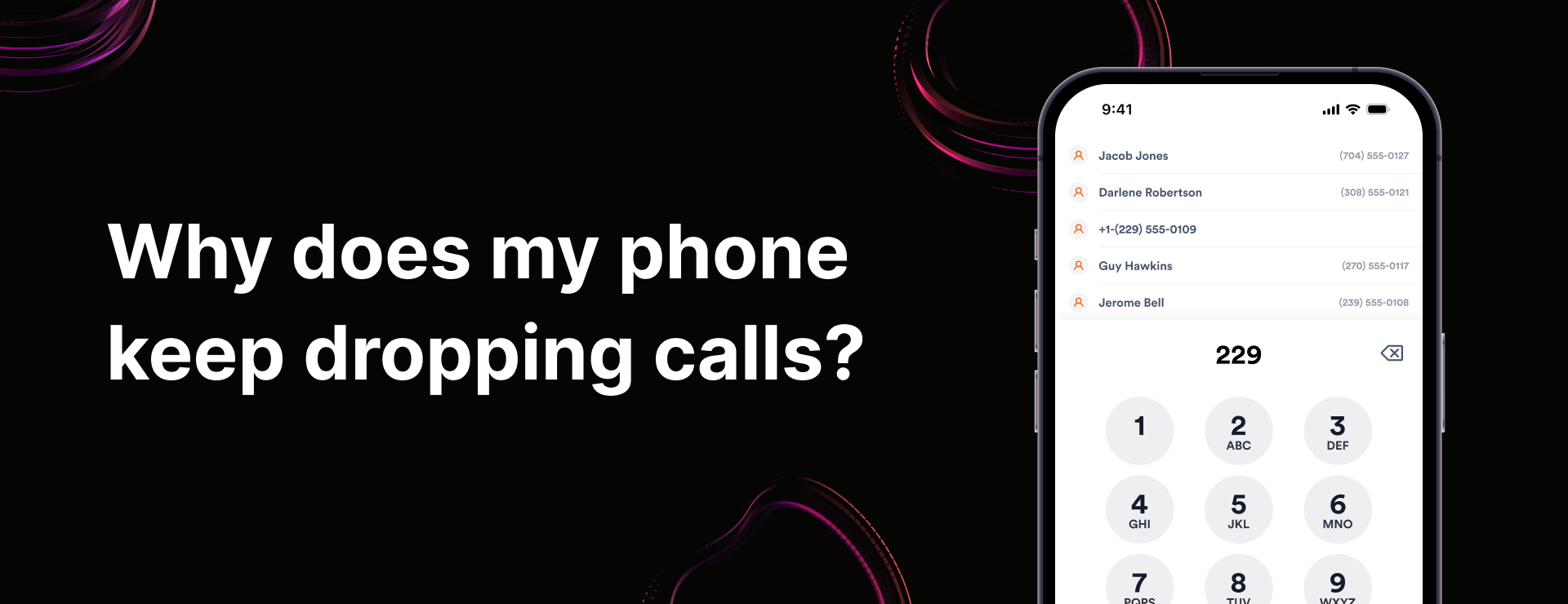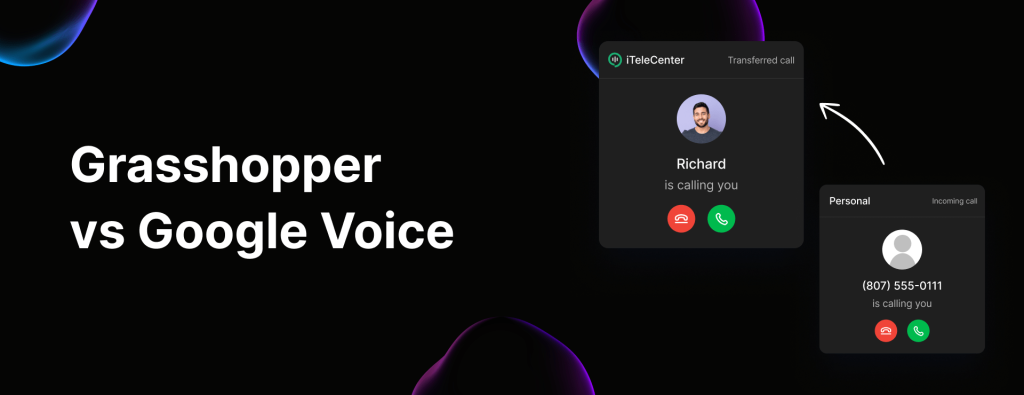Why does my phone keep dropping calls?

Getting cut off while Auntie Claire is mid-story is one thing.
But imagine you’re wrapping up an important business call only to realize you’ve been talking to yourself for the last few seconds. At this point, you’re about this close to chucking your phone out the window.
And you might be thinking, “hmm why does my phone keep dropping calls?“
Dropped calls are quite annoying. If you rely on your phone for business, you can’t afford to have conversations randomly cut off. If you’re dealing with them more than a couple of times a month … that’s a problem. Especially if you rely on your phone to talk to customers, close deals or stay connected with your team.
If this is starting to feel like a pattern, don’t worry. In this blog, we’ll dive into these causes and offer solutions to help you keep your conversations uninterrupted.
What is a dropped call?
If you’ve been in the middle of a call and POOF, the line has gone dead. And you’re like, “why does my phone keep dropping calls? This s*cks!“
That, my friend, is a dropped call. It happens when your phone call suddenly disconnects, usually because of poor signal or even a technical glitch.
If you really want to know how calls work, here it is:
- When you dial a number, your phone sets up a connection with your network.
- If you’re using cellular data, your phone sends signals to the nearest cell tower. If you’re on Wi-Fi, your call takes a ride through the internet.
- If you’re moving, your phone hands off the signal from one tower to another. But if something interrupts that process, say like a weak signal or switching networks, your call might not survive the jump.
Okay, but why does my phone keep dropping calls?
Dropped calls are unexpected and unpredictable. Normally, there’s a reason behind them.
Here are a few common culprits:
Device issues – If you’re using an old phone or have outdated software, that could be a problem. Even dropping your phone (enough times) can mess with its ability to hold a call.
Weak signal strength – If you’re far from a cell tower or surrounded by tall buildings, your signal might sometimes be too weak to keep the call going.
Cell tower is too crowded – Ever tried making a call in a packed stadium, during rush hour or when too many people are around you? Too many people can cause traffic jams for your signal, leading to dropped calls.
Carrier problems – Dead zones or poor coverage in certain areas can also randomly cut your call.
WiFi interference – If you’re using Wi-Fi calling, too many devices using your network can overload your bandwidth, making calls lag, drop or not go through at all.
Too many apps open – We’ve all been there – dozens of apps running, tons of tabs open and a phone that’s basically begging for a break. If your device is overloaded with background apps, it could be taking up your network resources.
Think of it this way, you’re trying to stream a show while downloading 20 others, your phone just can’t keep up. A clogged cache or too many active programs can slow down performance, leading to dropped calls.
Poor battery health – You ever notice your phone acting up when the battery’s on life support? That’s not just bad luck, poor battery health can actually mess with your signal.
A weak battery struggles to power your phone’s antenna properly, which means weaker reception and, yep, more dropped calls.
How to fix dropped calls when you’re on Wi-Fi
If you’re using a VoIP provider or a cloud-based phone system like iTeleCenter, your call quality depends entirely on your internet connection. Here’s how to make sure it’s not the culprit:
1. Check for weak connection alerts
Most VoIP apps will warn you if your internet connection is unstable.
If your app doesn’t have this feature, watch out for telltale signs of a weak connection like choppy audio, lag, sudden disconnects, etc.
2. Test your internet speed
A slow internet connection = bad call quality. Public Wi-Fi, overloaded networks or weak signals can cause serious lag.
To check your Wi-Fi speed, head over to SPEEDTEST You’ll need to be looking for at least 3-4 Mbps for a stable, high-quality connection.
If your speed’s too low, try:
– Switching to a different Wi-Fi network
– Moving closer to your router
3. Restart your router or move it to another place
Routers need good placement to work properly. If your WiFi is struggling, try:
– Moving the router to a central, open space
– Restarting it (sometimes the good old turn it off and on trick works, it’s silly we know)
– Checking if your internet provider is having issues
4. Use a Wi-Fi extender for better coverage
If your Wi-Fi signal barely makes it past one room, a Wi-Fi extender could really help, trust us. These devices boost your signal so you can make calls from anywhere, without having to sit in that one corner of the house where the Wi-Fi works best.
5. Try a wired connection
If you’re making calls from a laptop, ditch your Wi-Fi and plug directly into your router using an Ethernet cable. It’s faster, more reliable and can help avoid call dropouts.
6. Call your internet provider
If your calls are still dropping, it’s time to bring in the big guns – your internet service provider. They might need to fix something on their end. If they can’t? Well, it might be time to switch providers.
How to fix dropped calls when you’re using cellular
“But I’m not in Wi-Fi, why does my phone keep dropping calls on cellular?“
If your calls keep dropping while using mobile data, here’s how to go about it:
1. Move to a less crowded area
Cell towers can only handle so much traffic at once. When too many people are making calls or streaming, your connection can take a hit.
If moving isn’t an option, you’re going to have to try switching to Wi-Fi. Most phones have a WiFi calling feature, and with a VoIP platform like iTeleCenter, you can make calls from your phone, laptop or tablet.
2. Get a little closer to a cell tower
The farther you are from a tower, the weaker your signal. Staying within a certain number of miles of a tower can improve your call quality.
3. Move away from big obstacles
Thick walls, valleys or heavily wooded areas can actually weaken your signal. You would’ve even noticed your calls drop as soon as you enter a tunnel, an elevator or a basement.
If your calls are cutting out in one spot but not another, your surroundings might be the culprit.
Try moving to a different location or use a network extender, which works like a WiFi booster but for your cell signal.
4. Check your phone’s setting
One wrong setting can really mess up your calls. Before assuming it’s your signal, here’s what you can double check:
– Airplane mode is off
– Your phone’s date and time are correct
– Caller ID is enabled
– If you’re using VoIP, then check its settings as well.
5. Take a look at your SIM card
Your SIM card is what connects you to the mobile network. If it’s damaged – say scratched, bent or loose, you might experience frequent dropped calls.
Try removing and reinserting it or taking it to your carrier to see if it needs replacement.
6. Your phone just can’t keep up
If your phone is too outdated to get new updates, it might be time for an upgrade. Or you can switch to a VoIP system and make calls from a tablet or laptop instead.
7. Close your background apps
If you’ve got too many apps running at once, you can slow down your phone and mess with your network connection.
– Close apps running in the background
– Reset your network settings
– Keep only your phone app open while on a call
Still dealing with dropped calls? It might be time to switch to a VoIP service like iTeleCenter, so you can make calls over WiFi and avoid signal issues altogether.
When should you do something about dropped calls?
A call dropping once in a while is cool. But if it keeps happening and you’re constantly thinking “why does my phone keep dropping calls all the time?”, it’s time to do something about it.
Here are some red flags to watch for,
- Dropped calls are hurting your business, losing 20+ calls or so a week isn’t just frustrating, it’s literally costing you.
- Certain locations are a dead zone, your carrier’s coverage might not be cutting it.
- Calls always drop at the same time or place and could be a bandwidth problem or weak signal.
Say GOODBYE to dropped calls

If you’re a business owner, dropped calls can be a nightmare. No one likes a conversation that cuts off mid-sentence especially when it’s with a customer. It could even lead to losing a paying customer.
With iTeleCenter, you can make calls and texts in the US and Canada over WiFi, plus 99.9% uptime, so your business stays connected when it matters most.
Try iTeleCenter free for fourteen days and experience the difference.
Frequently asked questions
How do I fix dropped calls on my iPhone?
It depends on your device, but here are a couple of things to try:
- Remove your SIM card, check for damage, and reinstall or replace it if needed
- Force restart your iPhone
If nothing works, reaching out to Apple Support might just be your best bet!
How do I stop my phone from dropping calls?
You can try moving to an area with better reception, switching over to Wi-Fi calling or checking for software updates. If the issue persists, a signal booster or carrier switch might help you.
Why do my phone calls end out of nowhere?
Most times dropped calls occur due to weak signals, network congestion or interference from physical obstacles. If it’s a frequent issue, you need to try troubleshooting your network or device settings.
Why does my phone keep hanging up on calls?
It could be a low battery, a faulty SIM card,or background apps using too much data. Restarting your phone, updating your software, or checking for hardware issues might fix it.
How can I improve the signal strength on my phone?
Try getting a little closer to a cell tower or using a signal booster to strengthen your connection. Checking coverage maps can also help you find spots with better reception, so you’re not stuck with a weak signal.
What should I do if my network is congested during peak times?
If your network is congested during peak times, try using Wi-Fi calling to reduce disruptions. This can help improve your call connection and make your experience smoother.
Table of Contents
Test drive iTeleCenter for free
Try for free



